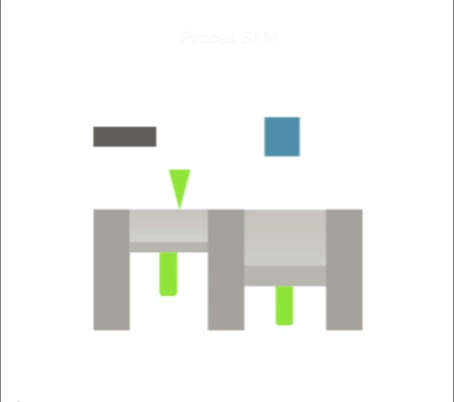Selective laser melting is a technique for the additive manufacturing of finished parts/products of any shape that are joined by a laser. A layer of powdered metal is placed on the machine’s work table and selectively molten, using a concentrated photon beam generated by a laser, in an area defined by the shape of this layer. This process is very similar to the SLS process, except that the parts must include designed supports that bond the part to the work table. They also cannot be manufactured on top of each other, as is the case with SLS. In the SLM process, the metal is completely molten into a permanent three-dimensional part, as opposed to SLS, where only the adjacent layers are partially molten. An alternative to this technique is Electron Beam Melting (EBM), which uses an electron beam as the energy source to melt the material.

Selective Laser Melting (SLM)
Type of technology
Development phase
Level of innovation
Scale of production
batch, unit
Technology readiness level TRL
Description of the technology
Purpose of use
additive manufacturing of finished parts/products of any shape
Use in industry
machine, automotive, aviation, medical, construction industries
Alternative technologies
- sintering
- casting
- machining
Visualisation of action
Advantages
- ability to produce parts with very complex shapes (impossible to achieve with machining)
- high mechanical properties of the products
- high geometric repeatability of manufactured parts
- lower porosity of SLM-manufactured products compared to SLS-manufactured products
Disadvantages
- relatively high surface roughness of machined surfaces compared to parts produced by conventional methods (often requiring further subtractive machining)
- the technique is not suitable for batch production/mass production
- high investment cost
- printing of individual components/parts is not cost-effective
- limiting the process to producing relatively small parts
Workpiece material types
- metals
- metal carbides
Examples of products
- complex and lightweight components used in the aerospace industry (structural components/ clamps/fittings)
- complex and high-strength components used in rocket engines (nozzles or combustion chambers)
- models of surgical instruments with complex geometries (forceps or elements for bone reconstruction)
- prototype automotive components (engine housings; exhaust system components or complex fittings)
Implementation of the technology
Required resources
- SLM printer equipped with technological laser
- metal powders
- operating gases
Required competences
- training in metal sintering
- training in CAD/CAM systems
Environmental aspects
Expert evaluation
Development centers
- West Pomeranian University of Technology
- AGH University of Krakow
- Warsaw University of Technology
- Poznan University of Technology
- Cracow University of Technology
